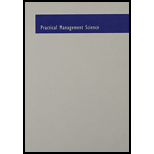
Concept explainers
a)
To explain: The way (1), (2), and (3) changes as the setup cost ‘k’ decreases by 10%.
Inventory and supply chain models:
The functions of inventory and supply chain are one of the most important business decision areas for an organization. The first important aspect of these concepts is to have adequate inventory on hand. The second important aspect is to carry a little amount of inventory as possible.
a)
Explanation of Solution
The economic order quantity (EOQ) is given by the formula:
The EOQ formula is substituted in the expression for annual holding cost and annual ordering cost to get the following result:
The time between orders is given by:
The values of (1), (2), and (3) are multiplied by
b)
To explain: The way (1), (2), and (3) changes if the annual demand doubles.
b)
Explanation of Solution
The economic order quantity (EOQ) is given by the formula:
The EOQ formula is substituted in the expression for annual holding cost and annual ordering cost to get the following result:
The time between orders is given by:
The values of (1), (2), and (3) are multiplied by
c)
To explain: The way (1), (2), and (3) changes if the cost of capital increases by 10%.
c)
Explanation of Solution
The economic order quantity (EOQ) is given by the formula:
The EOQ formula is substituted in the expression for annual holding cost and annual ordering cost to get the following result:
The time between orders is given by:
Since
Equation (2) is multiplied by
Equation (3) is multiplied by
Hence, the values change in such a way when the cost of capital increases by 10%.
d)
To explain: The way (1), (2), and (3) changes as the changes of setup cost decreasing by 10%, doubling of annual demand, the increase in the cost of capital by 10% happen simultaneously.
d)
Explanation of Solution
The economic order quantity (EOQ) is given by the formula:
The EOQ formula is substituted in the expression for annual holding cost and annual ordering cost to get the following result:
The time between orders is given by:
Equation (1) is multiplied by
Equation (2) is multiplied by
Equation (3) is multiplied by
Hence, the above changes happen due to the simultaneous changes in the various values.
Want to see more full solutions like this?
Chapter 12 Solutions
Practical Management Science, Loose-leaf Version
- Hyundai Motors is considering three sites-A, B, and C-at which to locate a factory to build its new electric car batteries. The goal is to locate at a minimum-cost site, where cost is measured by the annual fixed plus variable costs of production. Hyundai Motors has gathered the following data: Site Annualized Fixed Cost Variable Cost per Battery Produced A $11,000,000 $2,600 B C $2,000 $1,100 $20,000,000 $25,000,000 The firm knows it will produce between 0 and 60,000 batteries at the new plant each year, but, thus far, that is the extent of its knowledge about production plans. a) The value of volume, V, of production above which site C is recommended = batteries (round your response up to the next whole number).arrow_forwardHyundai Motors is considering three sites-A, B, and C-at which to locate a factory to build its new electric car batteries. The goal is to locate at a minimum-cost site, where cost is measured by the annual fixed plus variable costs of production. Hyundai Motors has gathered the following data: Site Annualized Fixed Cost Variable Cost per Battery Produced A $11,000,000 $2,500 B C $2,100 $1,050 $20,000,000 $25,000,000 The firm knows it will produce between 0 and 60,000 batteries at the new plant each year, but, thus far, that is the extent of its knowledge about production plans. a) The value of volume, V, of production above which site C is recommended = batteries (round your response up to the next whole number).arrow_forwardThe importance of keeping track of invoices and budgeting in a nursing home kitchen and how can a nutritionist utilize this in their career? Please not just a short explanation.arrow_forward
- The importance of interviewing potential food service aides and how can a nutritionist utilize this in their career? Please not just a short explanation.arrow_forwardWhat role does job analysis and job evaluation play in the compensation decision? Give an example of an organization NO AIarrow_forwardI did the first half correct! Please help me with the second half, not quite sure of the naive approach. Thanks in advance!arrow_forward
- Because my tutor and I didnt get it rightarrow_forwardOperations Managementarrow_forwardHow does wellness reflect and impact the past and the future of our health as a workout routine? What are the obstacles during the workout routine, and how do you overcome the obstacles? What are the best solutions to plan and accomplish the wellness?arrow_forward
- My last question! Thank you all for helping me better understand how OM works. If you can assist me for this one I'd be very thankful. Can you explain it step by step?I know now that LS is late start, and ES is early start. - •Activities on the critical path are? •The total project completion time for Rafay Ishfaq's software firm is how many weeks?•Determine the slack time for each of the activities for A-F •What is the total slack for the non critical paths in Rafays project?arrow_forwardThank you so much! I was able to answer C without help! Can you assist me with slack time for A-F? I believe A=0arrow_forwardThere's 8 parts, but I need some help with them. I always get confused on which is most critical of a patharrow_forward
 Practical Management ScienceOperations ManagementISBN:9781337406659Author:WINSTON, Wayne L.Publisher:Cengage,
Practical Management ScienceOperations ManagementISBN:9781337406659Author:WINSTON, Wayne L.Publisher:Cengage, Purchasing and Supply Chain ManagementOperations ManagementISBN:9781285869681Author:Robert M. Monczka, Robert B. Handfield, Larry C. Giunipero, James L. PattersonPublisher:Cengage LearningMarketingMarketingISBN:9780357033791Author:Pride, William MPublisher:South Western Educational Publishing
Purchasing and Supply Chain ManagementOperations ManagementISBN:9781285869681Author:Robert M. Monczka, Robert B. Handfield, Larry C. Giunipero, James L. PattersonPublisher:Cengage LearningMarketingMarketingISBN:9780357033791Author:Pride, William MPublisher:South Western Educational Publishing


